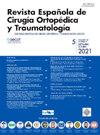根据Insall-Salvati指数,与生物增强术相比,急性髌骨肌腱断裂的孤立修复术显示出更高的术后髌骨高度
Q3 Medicine
Revista Espanola de Cirugia Ortopedica y Traumatologia
Pub Date : 2025-07-01
DOI:10.1016/j.recot.2025.04.008
引用次数: 0
摘要
背景与目的髌骨肌腱断裂是一种罕见但致残程度高的损伤。手术治疗是标准的方法。术后髌骨高度(PH)用于确定干预是否成功,文献中描述了各种指标。该研究的目的是根据Insall-Salvati指数确定两组急性PTR患者在术后立即和4个月时的PH是否存在差异:第一组患者采用孤立修复技术(IR),第二组患者采用自体移植物或同种异体移植物加入修复(BAR)的生物增强。我们的假设是BAR组在术后即刻和术后4个月的PH值较低。材料和方法回顾性分析2016年至2022年在我中心治疗的所有急性PTR患者。手术后肌腱再次断裂的患者和非生物增强的患者被排除在外。根据Insall-Salvati指数的PH值由三位膝关节外科亚专科的骨科医生分别在术后一天和术后4个月拍摄的x线片测量。第四个盲评估者分析了测量结果,确定了三个评估者之间绝对一致的平均PH和类内相关系数。主要结果是两组患者术后一天和术后4个月PH值的差异。次要结果是两组术后立即测量和4个月时PH值的差异。结果本研究为回顾性观察性研究。包括31个手术膝关节。膝关节IR 15例(48.38%),生物增强16例。观察者1和观察者2的类内相关系数为0.88;2和3之间为0.89;观察者1号和观察者3号之间的比值是0.92,这表明观察者之间至少有很大的一致性。IR组术后1天和术后4个月的平均install - salvati指数分别为1.15和1.21,BAR组为0.97和1.07。两组之间的install - salvati指数有统计学上的显著差异,均在术后一天测量(p <;0.0001)和4个月时(p = 0.0002)。此外,观察到显著差异表明,当比较术后立即测量和4个月时,每个研究组的平均PH值增加(IR p = 0.0016, BAR p <;0.0001)。结论BAR患者的Insall-Salvati指数在术后1天和术后4个月均明显降低。此外,无论采用何种手术技术,在4个月时观察到PH显著增加。在该队列中,PH测量取得了实质性的观察者间协议。本文章由计算机程序翻译,如有差异,请以英文原文为准。
[Translated article] Isolated repair shows higher postoperative patellar height according to the Insall–Salvati index compared to biological augmentation in acute patellar tendon ruptures
Background and objective
Patellar tendon ruptures (PTR) are rare but highly disabling injuries. Surgical treatment is the standard approach. Postoperative patellar height (PH) is used to determine the success of the intervention, with various indices described in the literature. The objective of the study was to determine if there are differences in PH according to the Insall–Salvati index in the immediate postoperative period and at 4 months, between two groups of patients operated on for acute PTR: The first group underwent isolated repair techniques (IR) and the second group had biological augmentation with autograft or allograft added to the repair (BAR). Our hypothesis was that the BAR group would have lower PH in the immediate postoperative period and at 4 months.
Materials and methods
All patients with acute PTR treated at our centre between 2016 and 2022 were reviewed retrospectively. Patients with re-rupture of the operated tendon and those with non-biological augmentation were excluded. PH according to the Insall–Salvati index was measured in radiographs taken the day after surgery and at 4 months postoperatively by three orthopaedic surgeons with a subspecialty in knee surgery, independently. A fourth blind evaluator analysed the measurement results, determining the average PH and the intraclass correlation coefficient for absolute agreement among the three evaluators. The primary outcome was the difference in PH between both groups the day after surgery and at 4 months. The secondary outcome was the difference in PH between the immediate postoperative measurement and at 4 months in both groups.
Results
This was a retrospective observational study. Thirty-one operated knees were included. IR was performed on 15 knees (48.38%), and biological augmentation was added in 16. The intraclass correlation coefficient between observer 1 and 2 was 0.88; between 2 and 3 it was 0.89; and between observers 1 and 3 it was 0.92, showing at least substantial agreement among observers. The average Insall–Salvati index the day after surgery and at 4 months was 1.15 and 1.21 for the IR group, and 0.97 and 1.07 for the BAR group, respectively. A statistically significant difference in the Insall–Salvati index was found between the two groups, both in the measurement taken the day after surgery (p < 0.0001) and at 4 months (p = 0.0002). Additionally, significant differences were observed indicating an increase in average PH when comparing the immediate postoperative measurement and at 4 months in each study group (for IR p = 0.0016 and for BAR p < 0.0001).
Conclusions
The Insall–Salvati index was significantly lower in BAR cases both the day after surgery and at 4 months postoperatively. Additionally, a significant increase in PH was observed at 4 months, regardless of the surgical technique used. Substantial inter-observer agreement was achieved for PH measurement in this cohort.
求助全文
通过发布文献求助,成功后即可免费获取论文全文。
去求助
来源期刊

Revista Espanola de Cirugia Ortopedica y Traumatologia
Medicine-Surgery
CiteScore
1.10
自引率
0.00%
发文量
156
审稿时长
51 weeks
期刊介绍:
Es una magnífica revista para acceder a los mejores artículos de investigación en la especialidad y los casos clínicos de mayor interés. Además, es la Publicación Oficial de la Sociedad, y está incluida en prestigiosos índices de referencia en medicina.
 求助内容:
求助内容: 应助结果提醒方式:
应助结果提醒方式:


